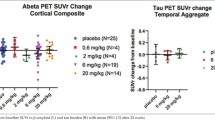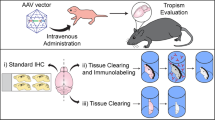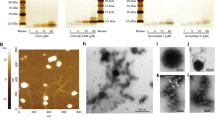Abstract
Presently, there are no effective treatments for conditions characterized by protein misfolding, such as Alzheimer’s, Parkinson’s, and other diseases involving CNS. Since misfolding occurs at the earliest stage of the disease, it is likely to be involved in subsequent pathological developments. It has been found that NPT002 (bacteriophage M13) directly dissociates aggregates of misfolded proteins that form amyloid, including amyloid-β, tau and α-synuclein. For CNS applications, NPT002 requires delivery to the brain parenchyma, the target tissue. NPT002 is an elongated ~950 nm particle that cannot penetrate into the brain from the blood. Furthermore, phage particles, due to their size, cannot be effectively transported in vivo by diffusion. Considering the physiology of the leptomeningeal space, intrathecal administration appears to be a promising convection-driven avenue for NPT002 delivery. In this paper, we use positron emission tomography to investigate the transport of NPT002 in Macaca fascicularis. The data suggest that approximately 50 % of the administered dose can reach the cerebral leptomeningeal space after a single lumbar intrathecal injection. A biologically significant fraction of the phage then enters the brain, resulting in potentially therapeutic cortical and subcortical exposure.









Similar content being viewed by others
References
Karlsson F, Borrebaeck CA, et al. The mechanism of bacterial infection by filamentous phages involves molecular interactions between TolA and phage protein 3 domains. J Bacteriol. 2003;185(8):2628–34.
Solomon B. In vivo targeting of amyloid plaques via intranasal administration of phage anti-beta-amyloid antibodies. In: Advances in Alzheimer’s and Parkinson’s Disease. Advances in behavioral biology, vol. 57. New York: Springer; 2008. p. 273–8.
Gannon K, et al. NeuroPhage Pharmaceuticals, unpublished data on file. 2011–2012.
Gannon KS, Becker M, Lavie V, Tsubery H, Rockenstein E, Masliah E, et al. NPT001 targets Abeta, tau and alpha-synuclein aggregates in biochemical assays and in transgenic mouse models. Annual Meeting of Society for Neuroscience. Washington, DC; 2011.
Ksendzovsky A, Walbridge S, Saunders RC, Asthagiri AR, Heiss JD, Lonser RR. Convection-enhanced delivery of bacteriophage to the brain. J Neurosurg. 2012. doi:10.3171/.2012.4.jns111528.
Rennels ML, Gregory TF, Blaumanis OR, Fujimuto K, Grady PA. Evidence for a paravascular fluid circulation in the mammalian central nervous system, provided by rapid distribution of tracer protein throughout the brain from the subarachnoid spaces. Brain Res. 1985;326:47–63.
Davson H, Segal MB. Physiology of the CSF and blood–brain barriers. Boca Raton: CRC Press; 1995.
Calias P, Papisov M, Pan J, Savioli N, Belov V, et al. CNS penetration of intrathecal-lumbar idursulfase in the monkey, dog and mouse: implications for neurological outcomes of lysosomal storage disorder. plos one. 2012;7(1):e30341. doi:10.1371/journal.pone.0030341.
Wagner H-J, Pilgrim C, Brandl J. Penetration and removal of horseradish peroxidase injected into cerebrospinal fluid. Acta Neuropathol. 1974;27:299–315.
Belov VV, Bonab AA, Fischman AJ, Heartlein M, Calias P, Papisov MI. Iodine-124 as a label for pharmacological PET imaging. Mol Pharm. 2011;8(3):736–47.
Du Boulay GH. Pulsatile movements in the CSF pathways. Brit J Radiol. 1966;39:255–62.
Du Boulay GH, O’Connell J, Currie J, Bostick T, Verity P. Further investigation of pulsatile movements in the cerebrospinal fluid pathways. Acta Radiol. 1972;13:496–523.
Friedman JE, Watson Jr JA, Lam DW-H, Rokita SE. Iodotyrosine deiodinase is the first mammalian member of the NADH oxidase/flavin reductase superfamily. J Biol Chem. 2006;281:2812–9.
Ullberg S, Ewaldsson B. Distribution of radio-iodine studied by whole-body autoradiography. Acta Radiol Ther Phys Biol. 1964;2:24–32.
Hays MT, Solomom DH. Influence of the gastrointestinal iodide cycle on the early distribution of radioactive Iodide in man. J Clin Invest. 1965;44:117–27.
Harden RMcG, Alexander WD, Shimmins J, Chisholm D. A comparison between the gastric and salivary concentration of iodide, pertechnetate, and bromide in man. Gut. 1969;10:928–30.
Carney JPJ, Flynn JL, Cole KS, Fisher D, Schimel D, Via LE, et al. Preclinical PET/CT system for imaging non-human primates. IEEE Medical Imaging Conference. 2009; abstract M06-67.
Defrise M, Kinahan PE, Townsend DW, Michel C, Sibomana M, Newport DF. Exact and approximate rebinning algorithms for 3-D PET data. IEEE Trans Med Imag. 1997;16:145–58.
Farris Griffith, editor. The rat in laboratory investigation. Philadelphia: Lippincott; 1949. p. 196–7.
Levine JE, Povlishock JT, Becker DP. The morphological correlates of primate cerebrospinal fluid absorption. Brain Res. 1982;241:31–41.
Papisov M, Belov V, Fischman AJ, Belova E, Titus J, Gagne M. Delivery of proteins to CNS as seen and measured by positron emission tomography. Drug Deliv Trans Res. 2012 (in press).
Papisov M, Belov V, Fischman AJ, Bonab AA, Wiles M, Xie H, et al. PET imaging of enzyme pharmacokinetics in rats after IV and IT administration. Annual Meeting of SNM, Toronto, CA, June 2009.
Acknowledgments
This work was supported by a grant from NeuroPhage Pharmaceuticals, Inc. NeuroPhage also provided the purified and formulated bacteriophage M13 preparations, NPT001 and NPT002.
Author information
Authors and Affiliations
Corresponding author
Rights and permissions
About this article
Cite this article
Papisov, M.I., Belov, V., Belova, E. et al. Investigation of intrathecal transport of NPT002, a prospective therapeutic based on phage M13, in nonhuman primates. Drug Deliv. and Transl. Res. 2, 210–221 (2012). https://doi.org/10.1007/s13346-012-0074-2
Published:
Issue Date:
DOI: https://doi.org/10.1007/s13346-012-0074-2




